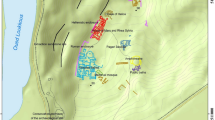Abstract
Gypsum-rich coatings found on buildings constructed with granitic rock ashlars have been studied, from both an urban and a rural area of the NW of Spain. Previous works have attributed gypsum to rock weathering by atmospheric pollution. Mineralogical, chemical, and physical data of coatings have allowed us to distinguish six different types of coatings formed in several ways. In most cases, they are originated by the deterioration calcium-rich plaster building materials. Sulfation of Ca-rich coatings, in situ gypsum dissolution and precipitation, and deposition of air pollution particles are the most important agents related to genesis of coatings. In fact, remains of plasters practically intact were found in some studied buildings. Also, data from coatings and rock ashlars suggest that gypsum-rich coatings are not formed by environment–rock interaction. Coatings located on different parts and façades of the buildings and submitted to different environmental conditions decay in a different way.







Similar content being viewed by others
References
Aranguren Iriarte, A. (1994). Estructura y cinemática del emplazamiento de los granitoides del Domo de Lugo y del Antiforme del Ollo de Sapo. A Coruña, Spain: O Castro.
Begonha, A., & Sequeira Braga, M. A. (1996). Black crusts and thin black layers in granitic monuments: their characterization and the role of air pollution. Berlin, Germany: 8th International Congress on Deterioration and Conservation of Stone, p. 371–375.
Blázquez, F., García-Vallès, M., Krumbein, W., Sterflinger, K., & Vendrell-Saz, M. (1997). Microstromatolitic deposits on granitic monuments: development and decay. European Journal of Mineralogy, 9, 889–901.
Carballeira, A., Devesa, C., Retuerto, R., Santillán, E., & Ucieda, F. (1983). Bioclimatología de Galicia. A Coruña, Spain: Fundación Pedro Barrié de la Maza.
Casal Porto, M. (1983). Estudio de la alteración del granito en los edificios de interés histórico de la provincia de La Coruña. Santiago, Spain: PhD, University of Santiago.
Chavas, A., & Lefèvre, R. (1996). Origine des constituants des croûtes sulfatées des monuments de Délos (Cyclades-Grèce). Berlin, Germany: 8th International Congress on Deterioration and Conservation of Stone, p. 415–422.
Chavas, A., & Jeannette, D. (2001). Weathering of marbles and granites in marine environment: petrophysical properties and special role of atmospheric salts. Environmental Geology, 40, 359–368. doi:10.1007/s002540000157.
Cultrone, G., De la Torre, M., Sebastian, J. E. M., & Cazalla, O. (2000). Behavior of brick samples in aggressive environments. Water, Air, and Soil Pollution, 119, 191–207. doi:10.1023/A:1005142612180.
De Vedia y Gossens, E. (1845). Historia y descripción de la ciudad de La Coruña. A Coruña, Spain: Imprenta Domingo Puga.
Del Monte, M., & Sabbioni, C. (1984). Gypsum crusts and fly ash particles on carbonate outcrops, Archives for Meteorology. Geophysics and Bioclimatology Series B, 35, 105–111. doi:10.1007/BF02269413.
Dorn, R. I. (1998). Rock coatings. Amsterdam: Elsevier.
MAGNA (1994). Mapa Geológico de España E 1:50000 La Coruña, 187. Madrid: IGME.
Moreda-Piñeiro, J., Moscoso-Pérez, C., Piñeiro-Iglesias, M., López-Mahía, P., Muniategui-Lorenzo, S., Fernández-Fernández, E., et al. (2007). Aqueous and acidified slurry sampling approaches in the As, Sb and Sn determination of urban dust samples by HG-ETAAS. Atomic Spectroscopy, 28, 137–143.
Pavía, S., & Caro, S. (2006). Origin of films on monumental stone. Studies in Conservation, 51, 177–188.
Pye, K., & Schiavon, N. (1989). Cause of sulphate attack on concrete, render and stone indicated by sulphur isotope ratios. Nature, 342, 663–664. doi:10.1038/342663a0.
Sanjurjo Sánchez, J., Vidal Romaní, J. R., & Alves, C. A. S. (2004). Characterisation typology and origin of patinas in the church of Las Capuchinas, A Coruña (NW Spain) pp. 202–206. Lisbon, Portugal: 6th International Symposium on Conservation of Monuments in the Mediterranean Basin.
Sanjurjo Sánchez, J., Vidal Romaní, J. R., Fernández Mosquera, D., & Alves, C. A. S. (2008). Study of origin and composition of coatings in a monument built with granitic rocks by SEM, XRD, XRF and DTA-TGA. X-Ray Spectrometry, 37, 346–354. doi:10.1002/xrs.1019.
Schiavon, N. (1993). Microfabrics of weathered granite in urban monuments. In M. J. Thiel (Ed.), Conservation of stone and other materials, vol I (pp. 271–278). London: E&FN Spon, Chapman & Hal.
Schiavon, N., Chiavari, G., Fabbri, D., & Schiavon, G. (1994). Microscopical and chemical analysis of black patinas on granite pp. 93–99. Venice, Italy: 3rd International Symposium on Conservation of Monuments in the Mediterranean Basin.
Smith, B. J., Magee, R. W., & Whalley, W. B. (1994). Breakdown patterns of quartz sandstone in a polluted urban environment, Belfast, Northern Ireland. In A. R. D. Robinson, & R. B. G. Williams (Eds.), Rock weathering and Landform evolution (pp. 131–150). Chichester, UK: Wiley.
Varela Diaz, R. (2004). Contaminación atmosférica en Galiza: inventario de emissions de gases de efecto invernadoiro, gases acidificantes e dioxinas (ano 2000). A Coruña, Spain: Baía.
Van Grieken, R., & Torfs, K. (1996). Atmospheric aerosols and deposition near historic buildings: chemistry, sources, interrelations and relevance. In F. Zezza (Ed.),Origin, mechanisms and effects of salts on degradation of monuments in marine and continental environments (pp. 24–35). Bari, Italy: European Commission, Research Workshop.
Acknowledgments
The Centro de Investigação Geológica, Ordenamento e Valorização de Recursos (Universidade do Minho) receives support from Programa de Financiamento Plurianual de Unidades de Investigação of the Portuguese Fundação para a Ciência e a Tecnologia, funded by European Union FEDER and national budget of the Portuguese Republic.
Financial support is from FEDER.
Author information
Authors and Affiliations
Corresponding author
Rights and permissions
About this article
Cite this article
Sanjurjo Sánchez, J., Alves, C.A.S., Vidal Romaní, J.R. et al. Origin of Gypsum-rich Coatings on Historic Buildings. Water Air Soil Pollut 204, 53–68 (2009). https://doi.org/10.1007/s11270-009-0025-9
Received:
Accepted:
Published:
Issue Date:
DOI: https://doi.org/10.1007/s11270-009-0025-9




